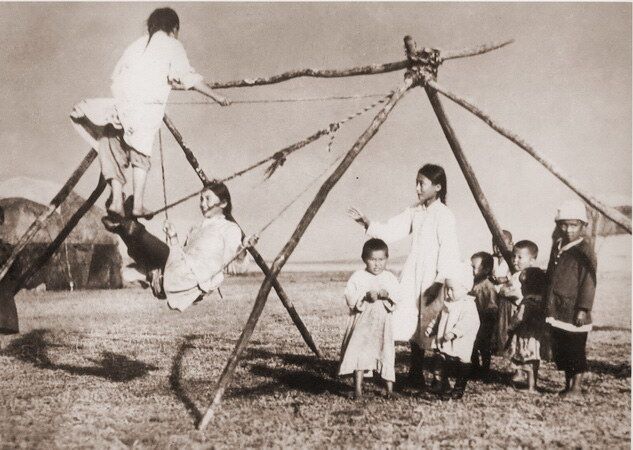
Many of them subsequently lost their original purpose, developing and being reinvented. The example of such games is alaman baiga, kokpar, saiys and audaryspak.
Kazakh people mostly led a nomadic life and the equestrian events and all kinds of horse competitions and games on horses developing strength, agility and courage in people were widespread. The veneration of horses and love of equestrian games have become Kazakh people’s tradition that preserved to our days. Intertwining of the entertaining game with the elements of the spiritual culture an art song had an important meaning in each game.
Let us consider some of the common games of Kazakh people.
Baiga is the horse race for middle-distances (3, 6, 9km) which is one of the most ancient and popular competitions. Baiga was held on all holidays and was available to everyone. Kazakh baiga was arranged on the flat terrain in a vicious circle. The races were held on the following distances: from 1,2 to 2 km for horses not older 3 years (kunan baiga), from 2,5 to 4,8 km for horses up to 4 years (donen baiga); from 5 to 8 km for horses in the age of 5 and older (baiga). The prizes were different depending on the number of riders, mostly up to 3-5 riders.
Kokpar tartu is known as goat shredding in common parlance. The origin of kokpar has several origins: firstly, the players of the game depict the ravenous wolves attacking the flock and kill the sheep likewise; secondly, they escaped with the loot in this manner and thirdly probably rescued a wounded warrior in like vein. The aim of the game — to bring thrown goat carcass to the agreed place first. Everyone tries to grab the carcass by the referee’s signal, the rest rushed in pursuit to snatch the kill. So the rider who caught the carcass tries to hold it tight in the saddle, holding under the leg or throwing from one side to another from other competitors and break away from his pursuers.
Kyz kuu, the main point of this game is that the horseman must catch the girl on the horse. According to the ancient custom prevalent in the Sak tribe, before a young man marries a girl, ne had to prove his riding skills, the ability to stay in a saddle. The custom required the horseman to catch his bride on a horse. The game «Kyz kuu» was started on the holidays or gatherings. The girl and the man riding the horse came to the field. By the host’s signal the girl beating a horse with a whip rushed ahead and the man riding on the horse tried to catch her and kiss. If he failed, then he had to ride away from the girl, as in this case, the girl began to whip him with power by catching him. All this used to turn to funny and entertaining performance for all gathered people.
Kume alu is the game, the meaning of which is «grab the coin». According to the rules of the game is that riders must collect as many coins wrapped in a handkerchief and scattered across the field on a specific turn by the signal. Initially, the game used silver ingots, which were later replaced by coins. Later the simplified children’s version of this competition has appeared.

Altybakan (literally «six pillars») Kazakh swings built of six pillars, the ends of which were drawn with a strong rope, a cross-pole was established on the top, where a pair of ropes for legs and a seat was secured. Altybakan is the entertainment for young people and therefore it was held in the evening. A girl and a boy swayed on a swing and had to begin a merry song, the others sang together, played the dombra and couples replaced each other. Youth games contrary to the provisions Shariat, contributed to a close acquaintance, understanding, friendship between boys and girls, which usually turned into love.
Asyk atu is originally children’s game in colored and hooved knuckles. The other representatives of aul — young people and adults often joined to this game. There are some variants of playing asyk. The most famous alshi, onka khan, best as, atbakyl, zhirma bir, the payoff was knuckles or money. Kazakh people also played games which are common in other nations, for instance, blind man’s bluff (zhasrynbak, sokyr teke, sokyr siyr), guessed riddles (zhumbaktar). Thus, the games historically common among Kazakh people covered many aspects of its labor, spiritual activity and life, both settled and nomadic. Most of the games continued existence, but in different way. Over time, with changing of society’s material life, the form and content of the game has changed.

